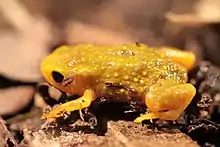Brachycephalus nodoterga
Brachycephalus nodoterga, also known as the Serra Cantareira saddleback toad, is a species of frog in the family Brachycephalidae.[2] It is endemic to the eastern São Paulo state (both the mainland and Ilha de São Sebastião) of southeastern Brazil, and only known from five locations in Atlantic rainforest at altitudes of 700–900 m (2,300–3,000 ft).[3][4]
| Serra Cantareira saddleback toad | |
|---|---|
 | |
| Specimen from near Osasco | |
| Scientific classification | |
| Domain: | Eukaryota |
| Kingdom: | Animalia |
| Phylum: | Chordata |
| Class: | Amphibia |
| Order: | Anura |
| Family: | Brachycephalidae |
| Genus: | Brachycephalus |
| Species: | B. nodoterga |
| Binomial name | |
| Brachycephalus nodoterga Miranda-Ribeiro, 1920 | |
| Synonyms[2] | |
| |
Description
Adult males measure about 12 mm (0.5 in) and adult females about 13 mm (0.5 in) in snout–vent length; the largest females can reach 14.5 mm (0.6 in) SVL.[5] This tiny toad has bumpy skin and an overall yellow-orange colour, with its upperparts generally tending towards a duller and darker brownish-green hue.[3][4][6] Unlike the more conspicuously coloured B. ephippium and B. pernix, studies of B. nodoterga have not detected toxins in its skin or organs.[7]
Habitat and conservation
Little is known about its behavior, but like other saddleback toads it lives among leaf litter.[8] Its conservation status was last reviewed by the IUCN in 2004 where regarded as data deficient (insufficient information for rating it),[1] but an independent review in 2019 that used IUCN's criteria recommended that B. nodoterga should be recognised as vulnerable.[3]
References
- Débora Silvano, Ronald Heyer, Ulisses Caramaschi (2004). "Brachycephalus nodoterga". IUCN Red List of Threatened Species. 2004: e.T54454A11149387. doi:10.2305/IUCN.UK.2004.RLTS.T54454A11149387.en. Retrieved 17 November 2021.
{{cite journal}}: CS1 maint: multiple names: authors list (link) - Frost, Darrel R. (2020). "Brachycephalus nodoterga Miranda-Ribeiro, 1920". Amphibian Species of the World: An Online Reference. Version 6.1. American Museum of Natural History. doi:10.5531/db.vz.0001. Retrieved 9 October 2020.
- Bornschein, M.R.; M.R. Pie & L. Teixeira (2019). "Conservation status of Brachycephalus Toadlets (Anura: Brachycephalidae) from the Brazilian Atlantic rainforest". Diversity. 11 (9): 150. doi:10.3390/d11090150.
- Clemente-Carvalho, Rute B. G.; Perez, Sergio I.; Tonhatti, Carlos H.; Condez, Thais H.; Sawaya, Ricardo J.; Haddad, Celio F. B. & Reis, Sergio F. dos (March 2016). "Boundaries of morphological and molecular variation and the distribution range of a miniaturized froglet, Brachycephalus nodoterga (Anura: Brachycephalidae)". Journal of Herpetology. 50 (1): 169–178. doi:10.1670/14-119. S2CID 86345886.
- Heyer, W. R.; Rand, A. S.; Cruz, C. A. G.; Peixoto, O. L. & Nelson, C. E. (1990). "Frogs of Boracéia". Arquivos de Zoologia. 31: 231–410. doi:10.11606/issn.2176-7793.v31i4p231-410 (inactive 1 August 2023).
{{cite journal}}: CS1 maint: DOI inactive as of August 2023 (link) (Brachycephalus nodoterga: p. 245–246.) - Pombal, José P., Jr. (2010). "A posição taxonômica das "variedades" de Brachycephalus ephippium (Spix, 1824) descritas por Miranda-Ribeiro, 1920 (Amphibia, Anura, Brachycephalidae)". Boletim do Museu Nacional. Nova Série, Zoologia. 526: 1–12.
{{cite journal}}: CS1 maint: multiple names: authors list (link) - Pires, Osmindo R.; Sebben, Antonio; Schwartz, Elisabeth F.; Morales, Rodrigo A.V.; Bloch, Carlos & Schwartz, Carlos A. (2005). "Further report of the occurrence of tetrodotoxin and new analogues in the Anuran family Brachycephalidae". Toxicon. 45 (1): 73–79. doi:10.1016/j.toxicon.2004.09.016. PMID 15581685.
- Abegg, A.D.; F.R. Ortiz; B. Rocha & T.H. Condez (2015). "A new record for Brachycephalus nodoterga (Amphibia, Anura, Brachycephalidae) in the state of São Paulo, Brazil". Check List. 11 (5): 1769. doi:10.15560/11.5.1769.
